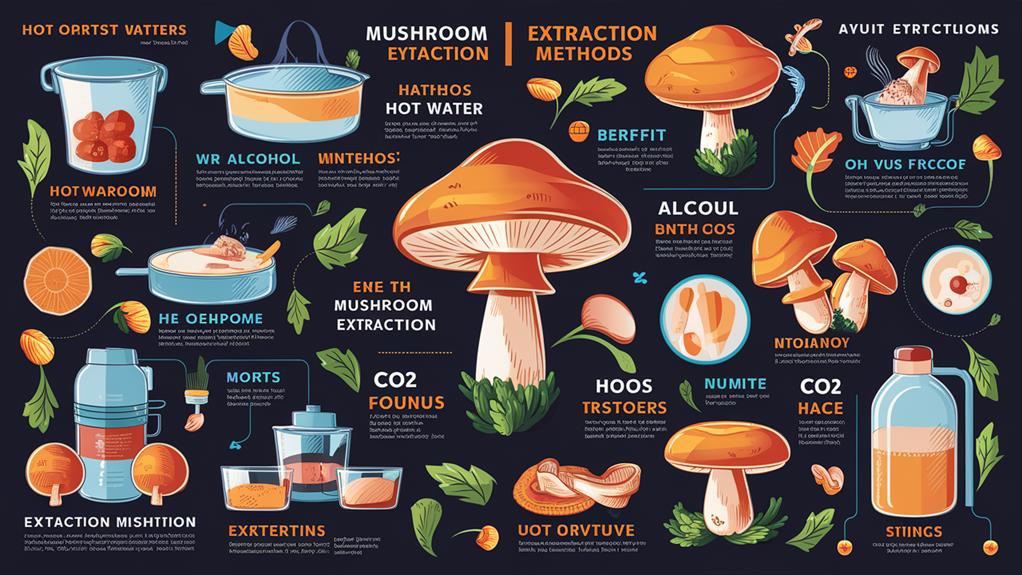
Choosing different mushroom extraction methods is crucial as each method unlocks specific bioactive compounds. For instance, hot water extraction is excellent for water-soluble polysaccharides like beta-glucans, which help boost your immune system. On the other hand, alcohol extraction targets non-water-soluble compounds, such as triterpenes known for their anti-tumor effects. Combining these methods can create a full-spectrum extract, offering a wider range of health benefits. If you pick ineffective methods, you might miss out on vital nutrients. Understanding these differences enhances your ability to reap the maximum health benefits mushrooms can provide. Discover more about this fascinating topic ahead.
Importance of Extraction Methods
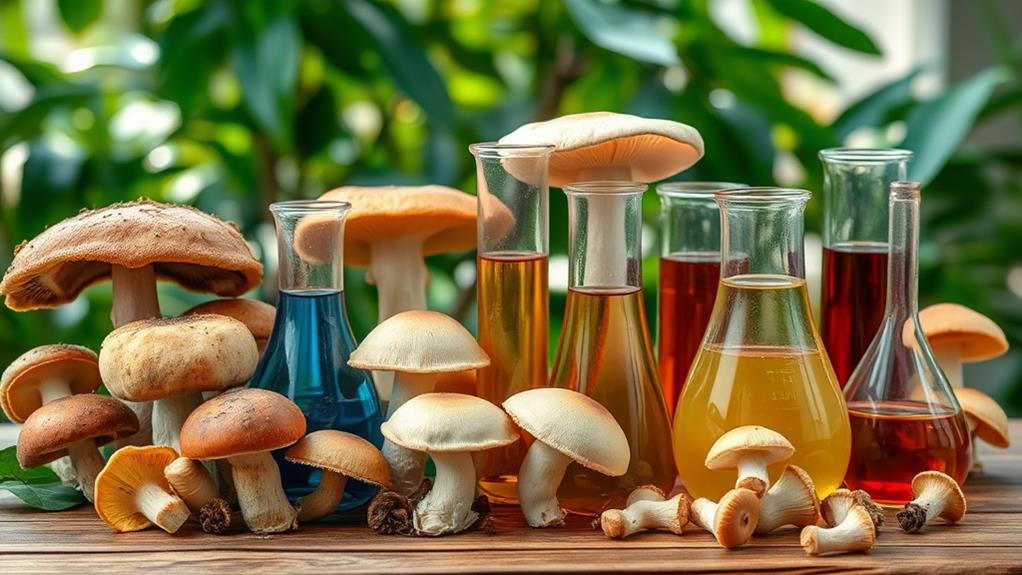
Extraction methods play a crucial role in unlocking the bioactive compounds within mushrooms. These methods are essential because mushrooms have chitinous cell walls that trap valuable compounds, making them hard to access. For optimal extraction, understanding the differences between methods is critical, as each method targets specific compounds.
If you want to benefit from medicinal mushrooms, choosing the right extraction method is key. For instance, hot water extraction is great for extracting water-soluble polysaccharides, like beta-glucans, which are known for their immune-boosting properties and gut health support. On the other hand, alcohol extraction targets non-water-soluble compounds, such as terpenoids and phenolics, which are vital for their bioactive effects, especially in mushrooms like Reishi and Chaga extracting bioactive constituents.
To get the most out of your mushrooms, consider using dual extraction. This technique combines hot water and alcohol methods, giving you a comprehensive profile of both water-soluble and non-water-soluble compounds. This way, you maximize the therapeutic potential of the mushrooms.
The choice of extraction method can significantly affect both the yield and bioactivity of the compounds you extract. For example, using advanced techniques like microwave-assisted extraction or supercritical fluid extraction can enhance efficiency and yield while keeping the structural integrity of the compounds intact.
Overview of Mushroom Compounds
When it comes to mushrooms, you'll find a variety of beneficial compounds that offer impressive health perks. These include bioactive substances like phenolics, flavonoids, and polysaccharides, each playing a unique role in nutrition and wellness.
The extraction methods employed can significantly impact the absorption and efficacy of these compounds, as different techniques target specific nutrients. For instance, the importance of extraction methods can enhance the bioactive profile of the final product.
It's important to remember that the method you choose for extraction can greatly influence the potency and effectiveness of these compounds.
Types of Mushroom Compounds
Mushrooms pack a punch when it comes to bioactive compounds that offer various health benefits. These beneficial compounds include polysaccharides, triterpenes, phenolic acids, and flavonoids, each playing a unique role in promoting health.
For instance, understanding the importance of extraction methods can significantly enhance the potency of these compounds. Polysaccharides like beta-glucans are especially noteworthy; they're known for their immune-enhancing and anti-inflammatory properties. When you think about the mushroom extraction process, remember that water and alcohol are common solvents used to extract these vital compounds.
Triterpenes, such as ganoderic acids found in mushrooms like reishi, also provide significant health advantages. They're often linked to anti-tumor and liver-protecting effects.
Then there are phenolic compounds, including chlorogenic and caffeic acids, which exhibit strong antioxidant activity. This helps combat oxidative stress in your body.
Finally, flavonoids like quercetin and catechin contribute to the anti-inflammatory and antioxidant capacities of mushrooms, enhancing their overall therapeutic potential.
Understanding these different types of mushroom compounds can help you appreciate why various extraction methods are essential. By choosing the right method, you can maximize the health benefits you gain from these incredible fungi.
Health Benefits Overview
The diverse bioactive compounds found in edible mushrooms offer a wealth of health benefits that can enhance your overall well-being. These mushrooms are packed with polysaccharides, which play a key role in boosting your immune system and even fighting cancer. For instance, beta-glucans, a type of polysaccharide, are renowned for their health-promoting properties, making them a valuable addition to your diet.
Additionally, the polyphenols in mushrooms, including flavonoids and phenolic acids, provide impressive antioxidant activity. This means they help reduce oxidative stress and inflammation in your body, which are linked to many chronic diseases. The total polyphenolic content can vary significantly, with some varieties showing impressive levels, such as Boletus edulis, which boasts a total polyphenolic content of over 4632.38 µg/g dry weight.
Moreover, the antioxidant activity in mushrooms can be substantial. For example, B. edulis exhibits 87.74% radical scavenging activity, showcasing its strong protective effects against free radicals.
Extraction Impact on Compounds
Understanding how different extraction methods impact the bioactive compounds in mushrooms can significantly enhance your ability to reap their health benefits.
Mushrooms are packed with various bioactive compounds, such as polysaccharides, triterpenes, phenolic acids, and flavonoids. Each of these compounds contributes uniquely to your nutrition and health.
Water-soluble compounds, like beta-glucans, are best extracted using hot water. This method ensures you get the most out of these beneficial polysaccharides. On the other hand, non-water-soluble compounds, such as triterpenes, require alcohol extraction for optimal yield.
The total phenolic content (TPC) in mushroom extracts can be incredibly high, sometimes reaching 4632.38 µg/g dry weight, depending on the extraction processes you choose. Acidic water methods show the highest efficiency in extracting these compounds.
Furthermore, different extraction techniques can lead to varying levels of antioxidant activity, with studies showing a strong link between TPC and Trolox equivalent antioxidant capacity (TEAC).
In essence, the extraction method you choose directly affects the bioavailability and therapeutic potential of mushroom compounds, so select wisely to maximize the health benefits you gain.
Common Extraction Techniques
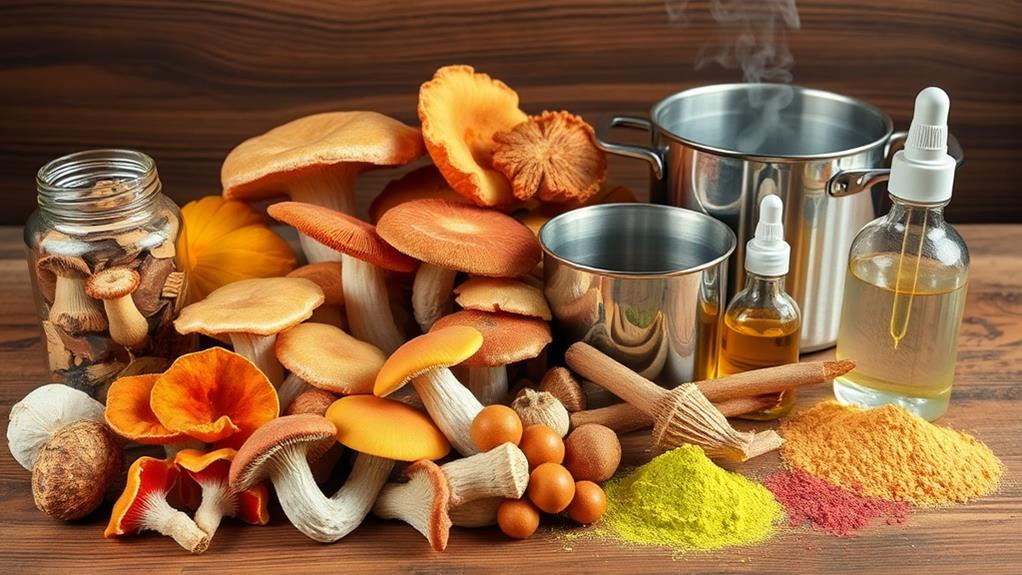
When it comes to extracting beneficial compounds from mushrooms, various techniques can be utilized to tap into their potential. One common method is hot water extraction, where mushrooms are simmered in water for 30 minutes up to several days. This process effectively pulls out water-soluble compounds like polysaccharides, such as beta-glucans, which are often added to beverages like tea and coffee.
Another popular technique is alcohol extraction. In this method, mushrooms soak in food-grade alcohol for one to six weeks. This allows for the extraction of non-water-soluble compounds, including terpenoids and phenolics, which are crucial for medicinal mushrooms like Reishi and Chaga.
For a more comprehensive approach, dual extraction combines both hot water and alcohol extraction. This method yields a full spectrum of bioactive compounds, ensuring you capture both water-soluble and non-water-soluble constituents.
There are also advanced techniques like microwave-assisted extraction (MAE) and supercritical fluid extraction (SFE). MAE uses microwave energy to improve extraction efficiency, while SFE employs supercritical fluids to selectively extract compounds, making it a more environmentally friendly option.
Benefits of Hot Water Extraction
Hot water extraction is a powerful method for getting the most nutrients out of mushrooms.
By simmering them, you not only release beneficial compounds like beta-glucans but also make them easier to use in cooking and drinks.
This technique is efficient, cost-effective, and versatile, making it a favorite for both home cooks and health enthusiasts.
Nutrient Extraction Efficiency
Mushroom extraction methods reveal that hot water extraction excels in nutrient efficiency, particularly for isolating beneficial compounds. This technique is highly effective at breaking down the tough cell walls of mushrooms, making it easier for your body to access the nutrients.
Here are some key benefits of hot water extraction:
- It isolates water-soluble polysaccharides like beta-glucans, known for boosting your immune system.
- The simmering process can last from 30 minutes to several days, ensuring maximum extraction of bioactive compounds.
- Research shows that this method produces significant amounts of antioxidant-rich compounds, enhancing the health benefits of mushrooms.
Health Benefits Overview
Utilizing hot water extraction unlocks a wealth of health benefits associated with mushrooms. This method is particularly effective in releasing water-soluble polysaccharides, like beta-glucans, which are known for their immune-boosting and anti-inflammatory properties. When you brew your favorite mushroom tea, you're not just enjoying a warm beverage; you're also tapping into these powerful compounds.
Hot water extraction is widely used in preparing drinks like tea and coffee, making it easy to incorporate these health benefits into your daily routine. Studies have shown that hot water extracts from mushrooms retain significant antioxidant activity, which can contribute to overall health and wellness. By concentrating bioactive components, this extraction method enhances the therapeutic effects you receive when consuming mushrooms in liquid or powdered form.
Mushrooms like shiitake and reishi are especially beneficial when extracted with hot water, as they contain high levels of polysaccharides that support immune function and promote general health.
Cooking Versatility and Use
When it comes to cooking versatility, hot water extraction offers a simple way to enhance the flavor and nutrition of various dishes. This method efficiently pulls out water-soluble compounds from edible fungi, making your meals not only tastier but also healthier.
Here are a few benefits of hot water extraction:
- It's an easy process, perfect for home cooks.
- You can use it in a variety of dishes, like teas, broths, and soups.
- It retains high antioxidant activity, boosting your overall wellness.
When mushroom extraction comes into play, you'll find that simmering mushrooms in water allows for optimal extraction of beneficial compounds like polysaccharides and beta-glucans. These compounds support immune health and reduce inflammation.
Plus, hot water extraction doesn't require any complex solvents, making it safe and accessible for anyone. This method mimics traditional cooking techniques, ensuring that you can seamlessly integrate the goodness of mushrooms into your everyday meals.
Advantages of Dual Extraction
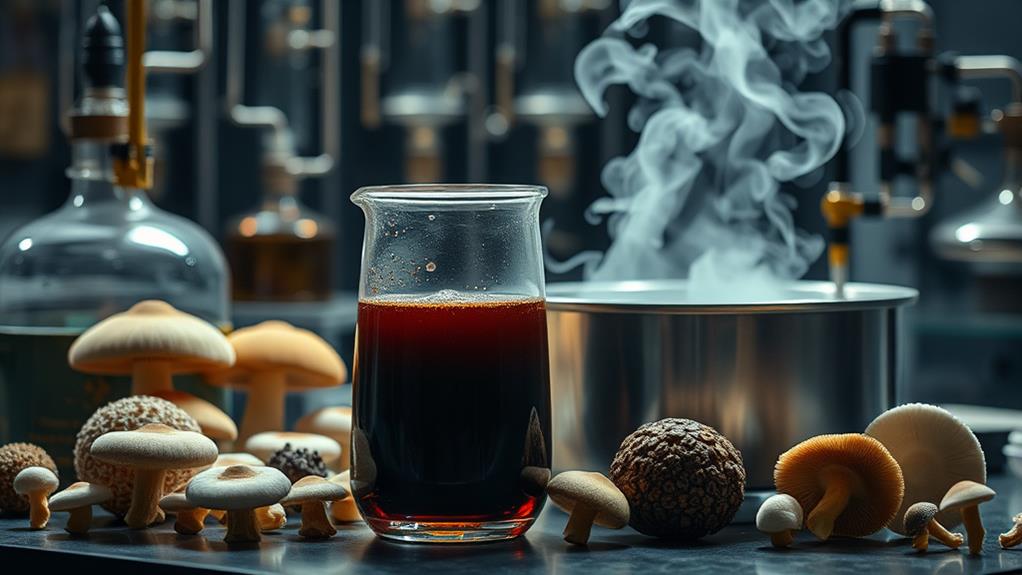
One of the standout benefits of dual extraction is its ability to maximize the bioactive potential of medicinal mushrooms. By combining hot water and alcohol methods, this technique effectively extracts both water-soluble compounds, like polysaccharides, and non-water-soluble compounds, such as triterpenes and phenolics. This means you get a full-spectrum mushroom extract that retains all the therapeutic properties of mushrooms like Reishi and Chaga.
While the dual extraction process can take longer, usually between 3 to 7 weeks, the result is well worth the wait. You'll enjoy a more comprehensive profile of bioactive compounds, enhancing the health benefits you receive from the mushroom.
This method allows manufacturers to create tinctures with higher concentrations of active ingredients, such as beta-glucans and triterpenoids, which single extraction methods might miss.
Research shows that dual extracts can provide higher antioxidant activity and improved health effects. For those looking to optimize their wellness, understanding the advantages of dual extraction is key.
Drawbacks of Ineffective Methods
Ineffective extraction methods can significantly undermine the therapeutic potential of medicinal mushrooms. When you rely on simple grinding or other shortcuts, you miss out on the benefits of powerful active compounds. Consider these drawbacks:
- Grinding doesn't break down chitinous cell walls, leaving you with a powder that lacks essential bioactive compounds.
- Fermentation often yields low levels of active compounds, failing to release valuable polysaccharides and triterpenoids effectively.
- Shortcuts like using cold water or insufficient heat compromise the bioavailability of crucial compounds.
These ineffective methods can lead to products that don't deliver the health benefits you expect. For mushrooms like Chaga and Reishi, dual extraction is vital; without it, you're left with subpar products that can diminish efficacy.
Moreover, quality assurance is critical, as some products might just be ground mushrooms instead of genuine extracts, which should show higher concentrations of beneficial compounds.
To fully harness the potential of medicinal mushrooms, it's essential to choose the right extraction methods that unlock the full spectrum of active compounds, ensuring you get the most out of your health supplements.
Choosing the Right Extraction Method
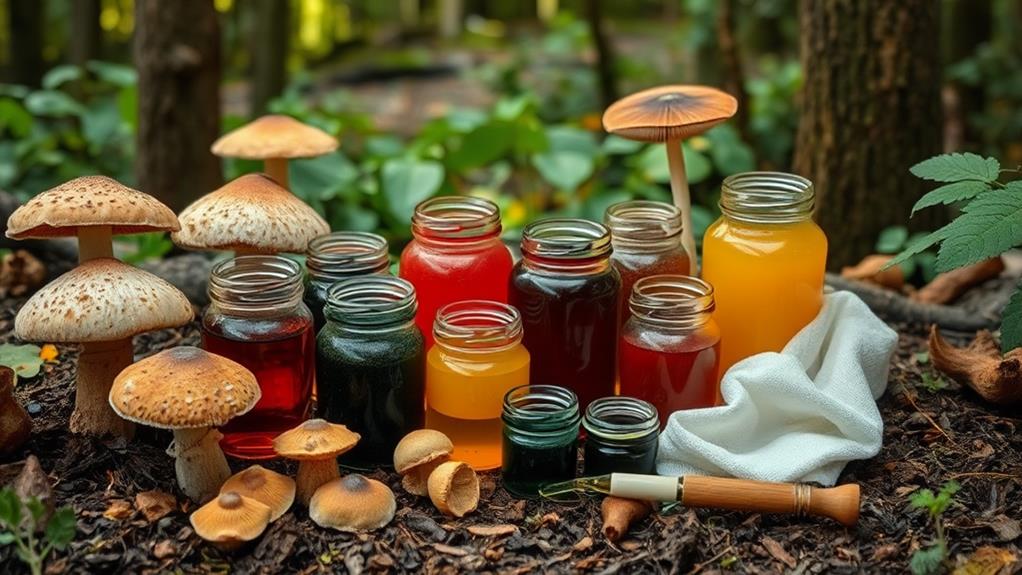
Selecting the right extraction method directly influences the potency of the active compounds in medicinal mushrooms. Each method, such as hot water extraction and alcohol extraction, targets specific bioactive compounds based on their chemical nature.
For instance, hot water extraction is excellent for isolating water-soluble polysaccharides like beta-glucans, which support your immune system. On the other hand, alcohol extraction is more effective for extracting non-water-soluble compounds such as triterpenes and phenolics.
If you want the best of both worlds, consider dual extraction. This method combines hot water and alcohol extraction to yield a broad range of bioactive compounds, making it ideal for popular medicinal mushrooms like Reishi and Chaga.
Understanding which compounds provide specific health benefits can help you choose the right extraction method for your needs.
Keep in mind that the choice of extraction method can significantly impact the effectiveness of the compounds you're consuming. For example, using acidic water has been shown to enhance the total phenolic content compared to other solvents.
Conclusion
In the grand world of mushroom extraction, picking the right method is almost as crucial as choosing your pizza toppings—do you really want pineapple on your fungi? Each extraction technique has its perks and pitfalls, so consider your goals carefully. Whether you're after health benefits or flavor, understanding these methods helps you make an informed choice. So, don't just wing it; dive into the details and let your mushroom journey be as rewarding as a perfectly cooked slice!
